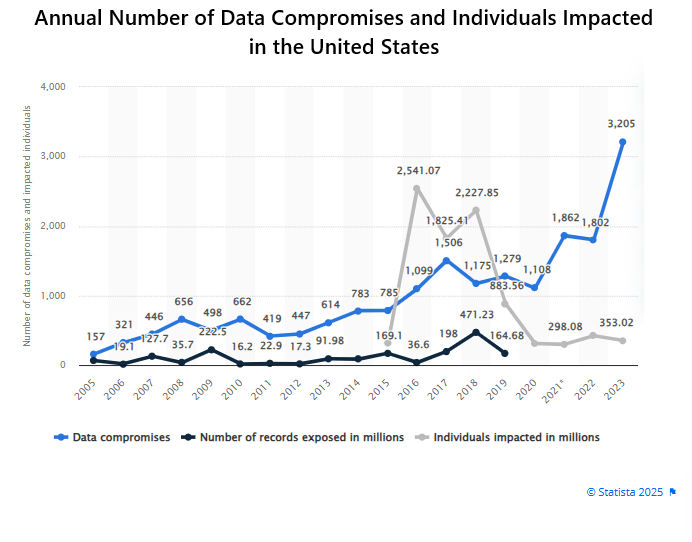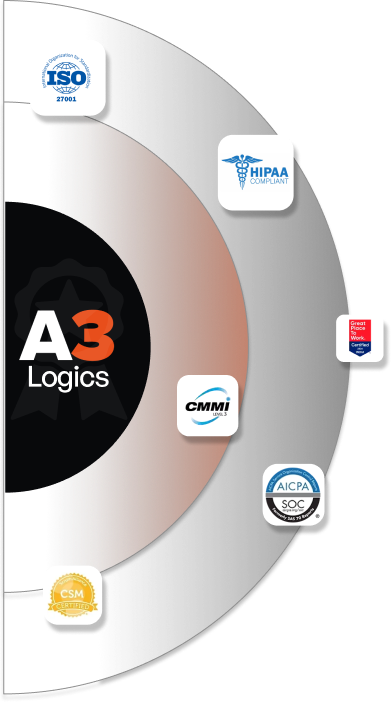With the increasing rate of data orientation, the impending risk of data breaches often seems to be a nightmare for companies across the world. In fact, 2024 saw a shocking 422.61 million data record breaches. So, this fear ensures that companies constantly explore the most advanced mode of data security, whether it be the blockchain or the newest Hedera Hashgraph. It is gradually proving to eat up a significant market share and reputation of the existing Distributed Ledger Technology (DLTs). This leads to the never-ending dilemma between sticking to the veteran past or giving scope to the efficient newcomer. Holding this string of discussion, this blog we will compare Hashgraph vs Blockchain. At the end of it, you will get clarity on the most secure, futuristic, and suitable form of DLT to invest in.

Table of Contents
What is Blockchain?
Blockchain is a distributed ledger technology for the secure, transparent, and tamper-resistant recording of transactions on a network of computers. Blockchain uses a series of blocks, each of which contains a list of transactions. As blocks here form a chain-like sequential order, they are thoughtfully termed as “blockchain.”
Within a blockchain network, all the participants maintain a replica of the entire ledger, and the transactions are verified through consensus algorithms like Proof of Work (PoW) or Proof of Stake (PoS). The consensus algorithms validate that all network participants are unanimous in accepting or rejecting the validity of transactions.
Blockchain’s decentralization has given it a higher status within cryptocurrency networks like Bitcoin and Ethereum. However, issues like scalability, energy consumption, and transaction velocity within Blockchain have led to the implementation of other forms of distributed ledgers like Hedera Hashgraph. However, at the forefront, you need to understand what distributed ledger technology actually is.
What Is Distributed Ledger Technology (DLT)?
Distributed Ledger Technology (DLT) is, basically, a decentralized database that is managed by multiple participants. It ensures transparency and security while sharing data and processing transactions. DLT is different from traditional databases as it does not possess a central point; thereby, it is less vulnerable to single points of failure.
The most popular form of DLT right now is Blockchain technology. However, other forms of distributed ledger technologies like Hedera Hashgraph are also expanding by addressing the loopholes in the existing technology. Let us explore the nuances of the before we delve deeper into the Hashgraph vs Blockchain domain.
What is a Hedera Hashgraph?
Hedera Hashgraph is a new but rapidly growing distributed ledger technology. Hedera Hashgraph saw a total market cap around $6.93 billion, and a fully diluted market cap of roughly $8.21 billion. It differs from blockchain in that it uses the application of a DAG structure, where transactions are linked in a non-linear fashion. Hedera Hashgraph’s largest distinction is in its consensus algorithm, which uses a mix of “Gossip about Gossip” as well as “Virtual Voting.”
Moreover, this DLT variant features a unique algorithm, the Asynchronous Byzantine Fault Tolerance or ABFT. This alone strengthens the security parameters higher with optimum clarity among the participants as it ensures consensus to reach all, even in the presence of faulty, malicious nodes.
Hedera Hashgraph is said to bring higher throughput, faster transactions, and greater security compared to current blockchain networks. It has a consensus architecture that is more energy-efficient with greater scalability. All these make Hedera a better choice for certain applications than blockchain technology.

Difference Between Hashgraph and Blockchain
There are some basic fundamental differences between the newest Hasgraphs and the comparatively seasoned Blockchains. To understand the potential of Hashgraph, therefore, you will have to get into the wrestling between Hashgraph vs Blockchain through the following parameters.
Consensus Mechanisms
When it comes to Hashgraph vs Blockchain – Blockchain typically employs consensus algorithms like Proof of Work (PoW) or Proof of Stake (PoS) to verify transactions. PoW is an appeal to miners to find complex computational problems while adding blocks to the chain, which takes high energy consumption and is slower in pace.
Meanwhile, Hedera Hashgraph employs Gossip about Gossip protocol and Virtual Voting in order to make a consensus. It allows faster confirmation of transactions without miners. As such, it is more efficient in terms of energy and scalability. Interestingly, while blockchain consensus is slow and energy-consuming, Hashgraph can confirm half a million transactions per second, which suits real-time better.
Transaction Speed and Throughput
Blockchain networks like Bitcoin and Ethereum have been suffering from scalability. Bitcoin can only process about seven transactions per second (TPS), while Ethereum can process about 30 TPS. This could result in network clogging, giving rise to delayed transaction speed as well as greater fees.
On the other hand, Hedera Hashgraph supports a high TPS of over 10,000. This is significantly quicker and more efficient in transaction processing, especially if there is high demand. Also, its transaction size scalability makes it a firm alternative to look out for larger enterprise solutions.
Security and Integrity
Both Hedera Hashgraph and blockchain protect transactions through decentralized mechanisms. Blockchain is, however, often afflicted with security vulnerabilities, such as 51% attacks, in which one individual or group of individuals controls more than half of the network’s hash rate so they can alter transactions.
Hedera Hashgraph uses a more robust consensus algorithm that makes it harder for any one party to take over the network. Hedera operates on Asynchronous Byzantine Fault Tolerance (ABFT). This means that even if there are malicious or offline nodes, the network will still agree and remain secure.
Scalability
One of the major drawbacks of blockchain is that it is not that scalable. With more nodes in the network, the consensus becomes more time-consuming as well as resource-consuming. If it’s in a linear shape, it simply can’t sustain as the network grows.
Hedera Hashgraph is more scalable with increasing network size. Due to its dependence on “Gossip of Gossip” and “Virtual Voting” to reach consensus, it will not be affected by the large number of transactions when executing, which makes it an appropriate platform for enterprise applications that demand high throughput and lower latency.
Energy Efficiency
Blockchain networks, especially Proof of Work networks, have an ill reputation for being power guzzlers. The Bitcoin network uses as much electricity as some small countries consume due to the computing power wasted in mining.
Hedera Hashgraph takes so much less power because it uses a more efficient consensus mechanism. Compared to the mining that blockchain uses, which is solving hard mathematical problems, Gossip about Gossip utilized in Hashgraph doesn’t need a lot of computer processing. It is thus much, much more efficient in terms of energy.
Code Availability
With regard to code accessibility, blockchain frameworks such as Ethereum offer open-source code and permission for developers to alter and augment the code. Open sourcing encourages innovation, but at times, it promotes vulnerabilities.
Hedera Hashgraph is both open and permissioned. Its consensus code is though public, certain aspects of its network (e.g., governance) are controlled by a trusted node council. This hybrid of openness alongside central control balances security and adaptability.
Transaction Fees
Transaction charges on blockchain networks can also be variable depending on network congestion. On Bitcoin and Ethereum, the fee rises as the network is heavily loaded, which makes microtransactions impractical.
This is in complete contrast to the case of Hedera Hashgraph. It has low and fixed transaction fees, even during high usage. This makes it an ideal choice for applications with high rates of transactions or micropayments.
Network Participants
Anyone can become a miner or node operator in a blockchain network if they meet the requirements of the network. Even though it supports decentralization, it also invites the scope of centralization through mining pools, such as in the case of Bitcoin.
Hedera Hashgraph does utilize a council of trusted nodes, and they are basically significant organizations and companies. It is more central than blockchain. Its governance is more stable and centered, especially suitable for corporate environments.
Hashgraph vs Blockchain
The war of relativity between Blockchain vs Hashgraph shows Hashgraph to be more suitable and futuristic. The table below has compiled key advantageous differences between Blockchain vs Hashgraph forms of Distributed Ledger Technologies.
| Components | Blockchain | Hedera Hashgraph |
| Consensus Mechanism | Proof of Work (PoW) or Proof of Stake (PoS) | Gossip about Gossip + Virtual Voting |
| Transaction Speed | Slow (7 TPS for Bitcoin, 30 TPS for Ethereum) | Fast (10,000+ TPS) |
| Scalability | Limited scalability | Highly scalable with low latency |
| Security | Vulnerable to 51% attacks | Byzantine Fault Tolerant (aBFT) offers more security |
| Energy Efficiency | High energy consumption (PoW) | Low energy consumption |
| Code Availability | Open-source | Open-source for consensus code with controlled governance |
| Transaction Fees | High during congestion | Low and predictable |
| Network Participants | Decentralized, open to all | Centralized council of trusted nodes |
How Do Blockchain and Hashgraph Work? Technical Breakdown
Both Blockchain and Hedera Hashgraph are dedicated to providing decentralization, security, and transparency but through different architectures and approaches. Therefore, understand the technical backdrop of both of these DLTs before you head to a cryptocurrency wallet development company.
Blockchain Technicalities
- It utilizes transactions loaded in the form of blocks, which are connected with one another.
- Consensus algorithms like Proof of Work (PoW) or Proof of Stake (PoS) are employed by the network to verify blocks.
- A complete copy of the ledger is maintained in every participant (node) of the network.
- The PoW miner or the PoS validator authenticates the transaction by solving mathematical problems or providing hostage capital.
- Since the chain is unidirectional, a new transaction cannot be altered after insertion.
Hashgraph Technicalities
- In the place of blocks, it uses a DAG or Directed Acyclic Graph structure, where each transaction is linked but in a non-linear format.
- Gossip protocol spreads information throughout the network in order to reach a quick, real-time consensus.
- A Virtual Voting mechanism is employed in order to isolate transactions from computationally expensive activity.
- All nodes collectively validate transactions with high security and speed.
- Hedera Hashgraph turns scalable and efficient without the use of mining, and hence becomes energy-efficient.
Real-World Applications: Industries Using Blockchain and Hashgraph
Blockchain and Hedera Hashgraph both serve key purposes in quite a significant range of industries. Blockchain is best known to be associated with cryptocurrency. But with speedy and secure transactions, Hedera Hashgraph development services are already enjoying a growing interest among different business enthusiasts.
Blockchain Applications
- Financial Services: Blockchain offers transparent and secure transfers to tokens like Bitcoin and Ethereum. They open the door to decentralized finance (DeFi).
- Voting Systems: Blockchain makes the voting procedure secure. It helps in making elections tamper-proof with an immutable ledger to verify votes. Using blockchain, votes can be recorded without the risk of alterations.
- Supply Chain Management: Blockchain tracks the source and shipping of commodities along the supply chain. It verifies origins against counterfeiting.
- Healthcare: Blockchain shares patients’ medical history and health records with medical professionals immediately. It stores medical records while protecting patients’ privacy and makes the tracking of drug distribution seamless.
Hashgraph Applications
- Decentralized Applications: Hedera Hashgraph is used in developing scalable, secure dApps for fast, low-cost transactions.
- Financial Services: Hedera offers low-cost, real-time micropayments for wallets and remittances.
- Digital Identity: Hashgraph offers secure, verifiable identities of individuals and organizations without any cost to privacy.
- Content Distribution: Hashgraph is used for authenticating and securely distributing digital content, i.e., streamed games and video.
How to Choose the Right Distributed Ledger Technology (DLT) for Your Business?
The choice between Blockchain vs Hashgraph will be according to your organization’s own needs. If decentralization and openness are your goals, then Blockchain will be more fitting for you, particularly if you are dealing with applications in cryptocurrency.
However, if your business requires transaction speed, scalability, and minimal power consumption, Hedera Hashgraph is more fitting. Additionally, for businesses that require security and velocity, Hashgraph’s consensus algorithm is quick without much dependency on mining. Engaging the services of a Hedera Hashgraph development company will help guide you in implementing the finest DLT platform for your business requirements.
Hashgraph vs. Blockchain: A Future of Coexistence?
Blockchain vs Hashgraph – the debate has been the recent topic of discussion among many businesses. However, they can be an addition or complement to one another. Blockchain is already at a place in existing technology, where it is currently making irreversible and decentralized transactions easy due to its usefulness in cryptocurrencies like Bitcoin and Ethereum.
Contrastingly, with low power consumption, scalability, and high-speed transaction processing, Hedera Hashgraph meets the limitations of the Blockchain. It can, therefore, be a great component to use in micropayments for businesses and commercial applications, respectively. It involves a new consensus mechanism that is cheaper than the traditional blockchain.
Considering the sets of benefits offered by both these forms of DLTs, we can presume a future collaboration between them. Their hybrid model can seamlessly blend with a diverse range of applications in the future when one is being utilized in conjunction with the use of the other.
Launch Your Crypto/DLT Project Rapidly with A3Logics
A3Logics can assist you if you are considering creating a cryptocurrency or a DLT project. As a seasoned provider of Blockchain development services for years, they have sufficient experience in comprehending and designing secure, high-speed, and large-scale blockchain, as well as Hedera Hashgraph.
If you are in need of a cryptocurrency wallet implementation or creating a decentralized application, A3Logics as your Hedera Hashgraph development company can be your guide through the process. Their team of expert Blockchain developers will execute your project with the latest technology and deliver it on time. Therefore, you can hire Blockchain developers from A3Logics to deploy your project with the ease of on-time delivery.

Conclusion
In conclusion, Hedera Hashgraph is an innovative advancement in the DLT network, with some distinct advantages in comparison to the regular blockchain. Though blockchain undoubtedly becomes quite irreplaceable, with the strategic integration of Hashgraph with it, the future of decentralized finance and data handling will be more consumer-friendly, suggesting to you that it is quite the right time to invest in it.




